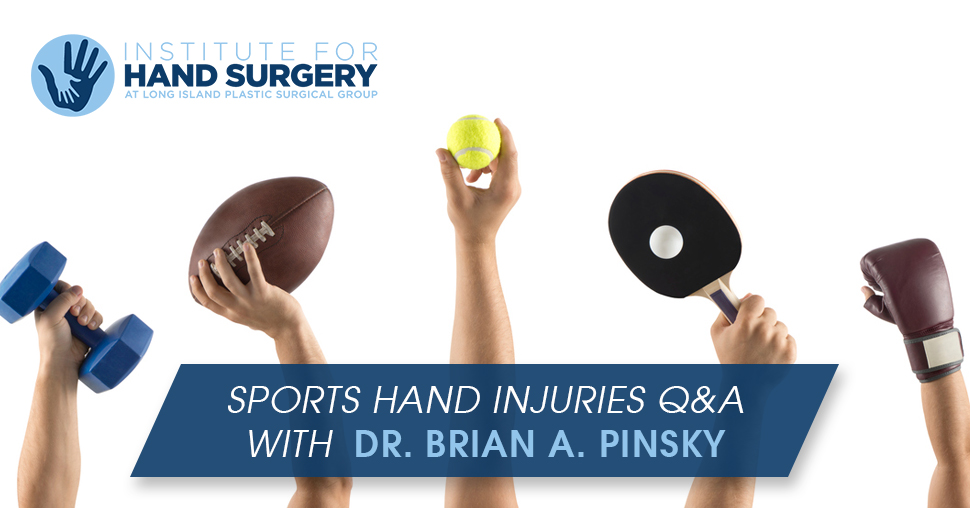
Sports Related Hand Injuries: A Q&A With Dr. Brian A. Pinsky
Brian A. Pinsky, MD, FACS is a board-certified plastic surgeon specializing in complex hand and wrist injuries at The Institute for Hand Surgery at Long Island Plastic Surgical Group. Dr. Pinsky also specializes in the treatment of rheumatoid arthritis, nerve injury, nerve compression, and Dupuytren’s contracture. In this discussion, Dr. Pinsky shares his knowledge and experience in the diagnosis and treatment of sports related hand injuries.
is a board-certified plastic surgeon specializing in complex hand and wrist injuries at The Institute for Hand Surgery at Long Island Plastic Surgical Group. Dr. Pinsky also specializes in the treatment of rheumatoid arthritis, nerve injury, nerve compression, and Dupuytren’s contracture. In this discussion, Dr. Pinsky shares his knowledge and experience in the diagnosis and treatment of sports related hand injuries.
What are some common sports injuries that you have seen involving the hand?
Common sports injuries can be divided into acute traumatic injuries versus chronic overuse injuries. Injuries to the hand and wrist are common at any level of competition and at any age. Common sports injuries range from minor to more severe that require surgery. I just treated a 9 year old in the emergency room who had a broken finger from playing baseball. The most common traumatic injuries I see are broken bones, dislocation, sprains, ligament injuries, and things of that nature.
How are sports hand injuries typically treated?
With any injury, unless it’s obviously severe, basic first aid is the first step. This includes ice, compression, elevation, and splinting. A non-steroidal anti-inflammatory, such as Motrin or Aleve can be helpful with most musculoskeletal injuries. This can be done on scene by coaching staff and trainers. Athletes should seek proper follow up with their primary care physician, who can help triage the injury and refer to proper specialists if needed. Most minor sports injuries will resolve within 1-2 weeks – if the injury persists beyond that, be sure to seek advanced care.
Any particular sports hand injury “case studies” you’d like to share?
I often see patients who are hit on the tip of a finger with a line drive baseball, these types of hyperextension injuries often result in a broken bone. Cases like these are usually seen in the emergency room for proper and immediate treatment. Finger joint injuries are super common, also referred to as “stubbed” or jammed finger”. This injury occurs often in any type of contact sport that involves a ball. The injuries range from simple sprain to full dislocation in a more severe type of trauma. These injuries should also be treated with basic first aid. An obvious deformity would need immediate medical attention. However, if a finger is swollen and can move, it may resolve on its own over time.
What advice do you have for athletes to avoid these types of hand injuries?
Injuries are unavoidable, the important thing is that they are recognized and treated properly when they happen. Most of these injuries occur in childhood sports and adolescent activities. A professional competitive athlete has different demands, and needs different medical consideration. In general, there’s no harm in letting a 9 year old sit out of sports for 3 months while they heal.
Any advice for parents or coaches?
A lot of chronic overuse injuries occur specifically in pitchers and competitive gymnasts. If a chronic injury becomes severe enough, the health of the athlete should be the paramount consideration. Remember, athletics are supposed to be fun and fulfilling. The overwhelming majority of people who participate in sports will not likely pursue it as a professional career, so please don’t risk long-term consequences or disability by rushing recovery.
Contact Us
The highly experienced surgeons at The Institute for Hand Surgery at Long Island Plastic Surgical Group utilize advanced training and expertise to treat injuries and conditions of the hand, upper extremity, and peripheral nervous system. Contact us to learn more or schedule a consultation.
Next Post

